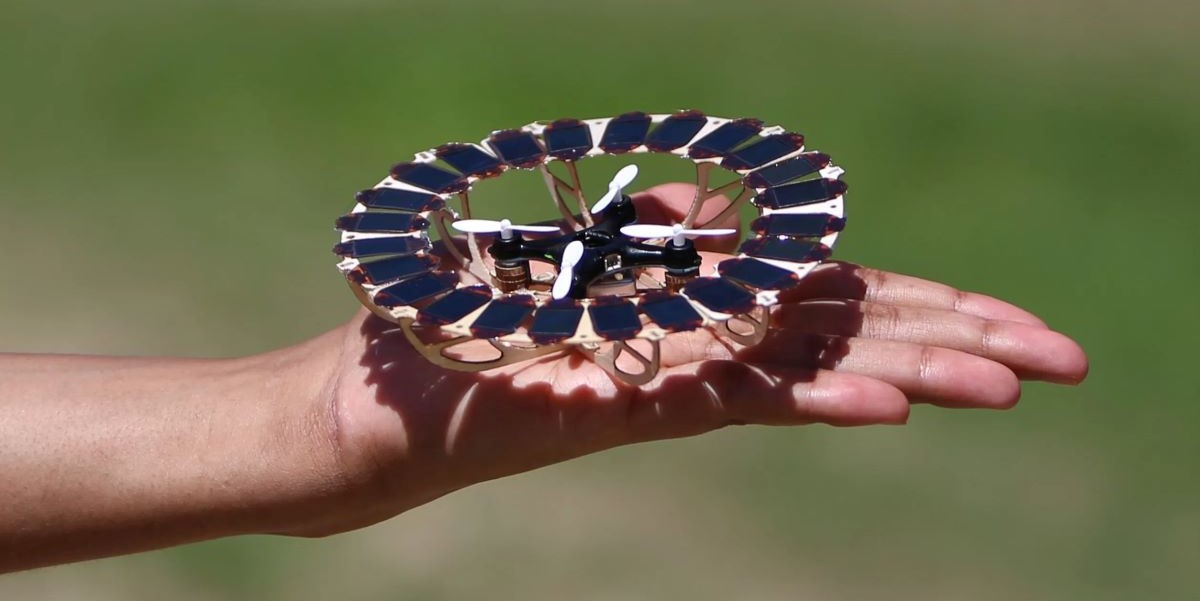A team from Johannes Kepler University Linz has developed lead halide perovskite solar cells that measure less than 2.5 μm thick with a champion specific PV power density of 44 W/g, and an average performance of 41 W/g, which they were able to integrate into modules to power palm-sized quadcopter-style drones.
The technology exhibited promising stability results under several standard tests, as well as the energy harvesting potential sufficient to recharge the vehicle's batteries. The details of their research appear in “Flexible quasi-2D perovskite solar cells with high specific power and improved stability for energy-autonomous drones,” published in nature energy.
The study’s large-area photovoltaic module, which measured 24 cm2, enabled the autonomous operation of the drone that extended “beyond what is possible on a single battery charge while eliminating the need for docking, tethered charging or other forms of human involvement.” The perovskite solar modules contributed just 1/400 th of the drone’s total weight.
The group tested several alpha-methylbenzyl ammonium iodide (MBA) combinations in the top perovskite absorber layer, with PEDOT:PSS combining hole transport and electrode functions. The longest lifetime of the various MBA formulations included cesium (Cs), indicating “a reduction of non-radiative recombination pathways due to the presence of MBA and Cs”, according to the researchers.
The substrate was an “ultrathin” and transparent-conductive-oxide-free 1.4-μm-thick polymer foil coated with a layer of 100 nm aluminum oxide. It effectively served as a “barrier” to moisture and gases.
“This type of device has no room for typical encapsulation approaches, which are just too thick. Instead, the team relied on the MBA perovskite top layer’s large, bulky crystal formation to effectively passivate the surface, and for the substrate, the aluminum oxide layer applied with atomic layer deposition (ALD) tool serves to protect from the external conditions, but still stay lightweight and flexible,” research leader, Martin Kaltenbrunner, told pv magazine.
Indeed, the paper notes, for example, that the water vapor transmission rate (WVTR) of the “coated ultrathin substrate was measured to be about 35% lower” when compared to the reference designs, which were methylammonium lead iodide (MAPbI3) devices.
Other features of the perovskite cell include an electron transport layer made of phenyl-C61-butyric acid methyl ester (PCBM) with a titanium oxide interlayer, and a metal top contact, which the group pointed out could be made interchangeably of gold, or chromium/gold, or low-cost aluminum.
“It is important in our perovskite solar research to use precursors that are synthesized in as few steps as possible. Straightforward synthesis is key because we want the technology to be scalable and to keep material production costs in check,” said Kaltenbrunner.
From cells to module
Popular content
The study’s small area perovskite solar cell measured 0.1 cm2 with an open circuit of 1.13 V, a short-circuit current density of 21.6 mA cm−2, a fill factor of 74.3%, and a power conversion efficiency of 18.1 %. The champion cells reached an open-circuit voltage of 1.15 V, a fill factor of 78%, and an efficiency of 20.1%.
The larger device had an active cell area of 1.0 cm2, with a mean open-circuit voltage of 1.11 V, a short-circuit density of 20.0 mA cm−2, a fill factor of 65.9%, and an efficiency of 14.7. The champion device reached an efficiency 16.3%, stated the research team.
The module for powering the drone had 24 interconnected 1 cm2 solar cells. The energy-autonomous hybrid solar-powered commercially available quadcopter-type drone weighed just 13 g.
The stability and prolonged outdoor operability were tested. For example, both the small- and large-area unencapsulated solar cells maintained 90% and 74% of initial performance, respectively, after 50 h continuous maximum power point tracking (MPPT) in ambient air. In addition, an external lab validated performance and properties of the perovskite composition.
The team asserted that it demonstrated the “broader benefits of using a quasi-2D perovskite active layer” and that it outperforms “other compositions in this field”, adding that the performance, stability, and usability of the ultra-lightweight perovskite solar technology is both a “portable and cost-effective sustainable energy harvesting” solution.
As a drone charging system, it is a step on the path to “perpetual-operation vehicle development” for both aerospace and terrestrial applications, it asserted.
The team has plans for further research along these lines. “We will continue to work continue to develop the AlOx barrier substrate technology, scalable deposition techniques, and to scale up to even larger modules, measuring at least 10 cm X 10 cm. We are intent on the development of lightweight, flexible PV solutions to power all kinds of robotics and autonomous vehicles,” said Kaltenbrunner. “There is great potential for deployable, flexible solar PV in both earth and space applications.”

Image: JKU
This content is protected by copyright and may not be reused. If you want to cooperate with us and would like to reuse some of our content, please contact: editors@pv-magazine.com.


1 comment
By submitting this form you agree to pv magazine using your data for the purposes of publishing your comment.
Your personal data will only be disclosed or otherwise transmitted to third parties for the purposes of spam filtering or if this is necessary for technical maintenance of the website. Any other transfer to third parties will not take place unless this is justified on the basis of applicable data protection regulations or if pv magazine is legally obliged to do so.
You may revoke this consent at any time with effect for the future, in which case your personal data will be deleted immediately. Otherwise, your data will be deleted if pv magazine has processed your request or the purpose of data storage is fulfilled.
Further information on data privacy can be found in our Data Protection Policy.